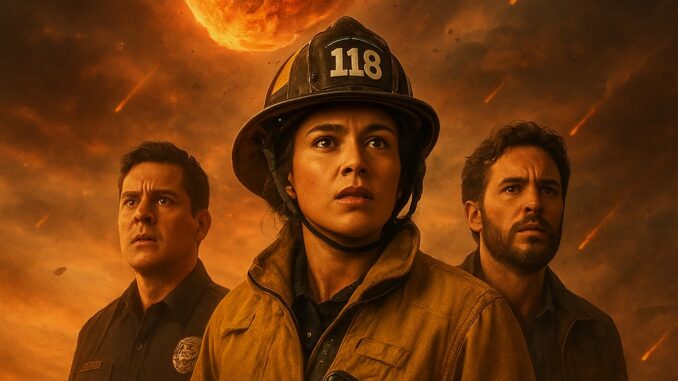
Did the Apocalyptic Threat in 9-1-1 Season 9 Actually Happen?
If you’re watching the teaser for 9-1-1 Season 9 and thinking, “Wow, that looks familiar,” you’re not alone. The season’s promo hints at a catastrophic event—one with a “falling sky” or apocalyptic vibe. What’s wild is that the writers didn’t pull this whole thing from thin air; there are real-life incidents that echo what we see in the promo.
Though the premise of the “sky falling” in 9-1-1 might seem like some over-the-top fictional drama, the idea actually has merit. Items have fallen from the sky in real life, which is likely where 9-1-1’s writers got the idea.
Starlink satellites, those put into orbit by Elon Musk’s SpaceX as part of an initiative to bring the internet to remote locations, are designed to function in Earth’s atmosphere for five years. At their lifetime’s end, they are “deorbited” by falling to Earth, but they are not supposed to make it to Earth since they burn up on their way.
It is not impossible, however, for debris from those satellites to fall to Earth, and in fact, they have. When debris began falling to Earth in early 2025, SpaceX released a statement noting that the chance of harm to a human being from the debris was “less than 1 in 100 million” (via PC Mag).
Despite it being unlikely that a person could be harmed from falling, burning, Starlink satellite debris, the number of satellites falling has increased in 2025. A study found that the upper atmosphere of the planet has been disrupted thanks to solar storms (via Economic Times). Solar storms cause larger amounts of solar energy to be released toward the Earth, disrupting the upper atmosphere where the satellites are in orbit. Those disruptions can then remove the satellites from their path and cause them to fall.
Breaking Down the Promo — What Disaster Is Teased?
The “Falling Sky” Imagery
-
Gigantic debris or meteor-like objects plummeting toward Los Angeles.
-
Mass destruction possibly threatening to overwhelm infrastructure.
-
Huge scale disaster seen in the trailer.
Threat to a Major City
The promotional material makes it clear: this isn’t a small-town disaster. This is Los Angeles—a sprawling metropolis with millions at risk. When major cities are in the crosshairs, you start looking for real life parallels.
Real-Life Events That Mirror the Fiction
1. Chelyabinsk Meteor, 2013
One of the most obvious parallels comes from Russia. A meteor exploded over Chelyabinsk, causing an enormous shockwave, shattered windows, injuries, and widespread damage. It scared the world. The writers of 9-1-1: Lone Star actually used that event as inspiration for an asteroid disaster storyline.
2. Recent “Falling Sky” & Atmospheric Anomalies
Early 2025 saw some strange atmospheric disturbances in parts of the world. Videos circulated of debris, falling skies, unidentified shapes—some natural, some not. While nothing turned fully apocalyptic, many pointed out how eerily similar it felt to the promo’s visuals. 9-1-1 producers themselves noted that the “falling sky” teaser has its roots in incidents that happened recently.
Why the Show Feels So “Realistic” This Time
Cultural & Atmospheric Anxiety
We’re living in a time of climate disasters, freak storms, wildfires, pandemics. We’ve seen real destruction. So when a TV show stages a city-threatening event, our minds immediately connect the dots. The level of realism in promos and trailers has gotten better—by design. The fear we already have helps make the fiction believable.
Blurring Fact and Fiction on TV
The 9-1-1 franchise has always drawn from real stories. Some episodes are directly inspired by recorded 911 calls, or public safety or natural disaster reports. They dramatize, yes—but foundations are often factual. Audiences crave that mix of “Is this what could happen?” and “What if?”
Which Real Events Could Be the Direct Inspiration?
Early 2025 “Falling Sky” Storms & Aerial Phenomena
There have been multiple reports across different regions of “sky objects,” falling debris from spacecraft, unidentified flying objects, or that weird glowing in the sky. Some were just atmospheric lens flares; others were dust or space debris. The show may be using these loosely as springboards.
Wildfire Disasters & LA’s Vulnerability
Los Angeles is prone to wildfires. In real life, portions of the sky turn orange, ash falls, and whole areas get evacuated. Visually, it’s a horror-movie effect. While 9-1-1 hasn’t confirmed a full wildfire apocalypse for S9, the imagery and thematic build-up borrow heavily from those disasters.
Satellite & Ordnance Re-Entries
Sometimes space debris re-enters and causes flashes, loud noises, or even minor damage. These events tend to make headlines: falling objects, meteor showers, etc. They stir up fear that something bigger is coming. When the show uses “falling sky” imagery, this is part of what it’s referencing.
What the Writers Might Be Trying to Say
Commentary on Unpredictability
The contrast between massive disasters that are hard to predict or stop, and the everyday heroes (911 operators, firefighters, medics) trying to save lives, is always compelling. The show has a chance to explore human resilience when facing something huge.
Fear as Connection
By tapping into what people are already worried about—sky disasters, climate chaos, freak atmospheric events—the show captures attention. It makes the audience ask: “Could this happen here? Could this happen now?” That fear makes fiction feel personal.
Key Differences Between Fiction & Reality
-
In 9-1-1, the apocalyptic event seems to threaten entire city infrastructure, mass casualties, dramatic visual spectacle. Real life disasters are often less cinematic—more messy, smaller scale, with complex aftermaths.
-
TV compresses timelines. What takes days, weeks, months in real life often happens in hours in a show.
-
Fiction amplifies stakes for emotional payoff. Reality has bureaucracy, delays, unexpected factors; the show will streamline or dramatize these.
How This Impacts Viewers & Society
Raising Disaster Awareness
Seeing these events in fictional form can push people to think about preparedness—emergency kits, natural disaster plans, infrastructure weakness. It can inspire conversation, maybe policy.
Triggering Trauma & Ethical Storytelling
Some viewers may have lived through similar disasters. The show must navigate telling disaster stories without trivializing or exploiting real suffering. There’s a fine line between engaging drama and insensitivity.
Predictions for 9-1-1 Season 9
Scale of the Apocalyptic Event
Expect big set pieces: falling debris, widespread panic, major damage to landmarks. Maybe even a citywide evacuation scenario.
Focus on First Responders’ Emotional Journey
The show will likely use the disaster to test characters—push them, break them, then show recovery. Emotional arcs of fear, sacrifice, grief, hope. Classic 9-1-1.
Tie-ins to Real-World Events
We may see nods to recent disasters—wildfires, storms, unclear aerial phenomena, climate shocks. The show might drop lines or visuals that feel ripped from recent headlines.
So, Has the Apocalyptic Event “Already Happened”?
The short answer: Yes and no. There hasn’t been a Hollywood-style apocalypse in L.A.—nothing quite matches the scale of what the promo shows. But many pieces of that disaster puzzle have occurred:
-
meteor airbursts
-
sky anomalies
-
massive wildfires with ash and smoke turning skies orange
-
destruction from storms and atmospheric debris
So while the full cinematic disaster hasn’t happened, much of what 9-1-1 is teasing is very much rooted in real events.
Why This Approach Resonates (and Sells)
-
It taps into collective anxiety. People are already nervous about climate, disasters, pandemics. Fiction that mirrors those fears hits harder.
-
Visual spectacular disasters draw attention. Trailers with “what if the sky fell?” get clicks.
-
It reminds us of the fragility of systems we take for granted—power, infrastructure, emergency response.
A Note of Caution for Viewers
It’s easy to blur what is real and what is amplified for drama. When watching, remember:
-
Not everything will be scientifically accurate.
-
Creative license is a large part of dramatization.
-
Emotional truth (how people would feel) often overtakes factual detail in shows like 9-1-1.

Final Thoughts Before the Season Drops
If 9-1-1 Season 9 plays things smart, it will use the apocalyptic event as more than just spectacle. It could be a mirror—showing real fears, pushing for empathy, maybe even raising awareness. The show has history doing big disaster-dramatic moments. But with this one, it seems closer to real world than ever.
Conclusion
9-1-1 Season 9’s teaser promises “apocalypse,” and while the show may exaggerate for drama—and will almost certainly do so—it draws from real events more than it lets on. Meteor strikes, atmospheric debris, wildfires, sky anomalies: these are things people have seen, lived, feared. The promo doesn’t just build hype—it taps into real dread. And that’s powerful. Whether or not Los Angeles faces such a disaster in the show, the idea that something like this could happen is what gives the fiction its weight.
5 FAQs
Q1: Is the event shown in the 9-1-1 Season 9 promo based on one specific real disaster?
A1: Not exactly one. It draws from several real incidents—meteor airbursts like Chelyabinsk, atmospheric anomalies, debris re-entry, wildfires—all combined into a dramatic, fictional apocalyptic scenario.
Q2: Did anything “apocalyptic” happen recently in real life that matches what’s in the promo?
A2: Sort of. Nothing has been quite as dramatic, but elements have occurred: falling debris/meteors, unusual skies, wildfires that turned skies orange or caused mass displacement. These serve as inspiration more than exact templates.
Q3: Is this storytelling approach new for 9-1-1?
A3: It’s a continuation. The show has frequently used real disasters or near-disasters to build episodes. But this seems elevated—the scope feels larger, the threat more existential.
Q4: Could this kind of “apocalyptic event” really happen in Los Angeles?
A4: In some forms, yes. Debris re-entry, wildfires, severe storms—these are plausible. A full city-destroying meteor strike is extremely unlikely, but fiction lives in “what if”—and 9-1-1 is leaning into that.
Q5: What should viewers keep in mind when watching the disaster unfold in Season 9?
A5: Remember that the show will exaggerate for emotional impact and visual drama. Scientific accuracy will likely take a back seat to storytelling. Also, the real power lies in how people respond—so pay attention to characters, relationships, and the aftermath, not just the spectacle.
